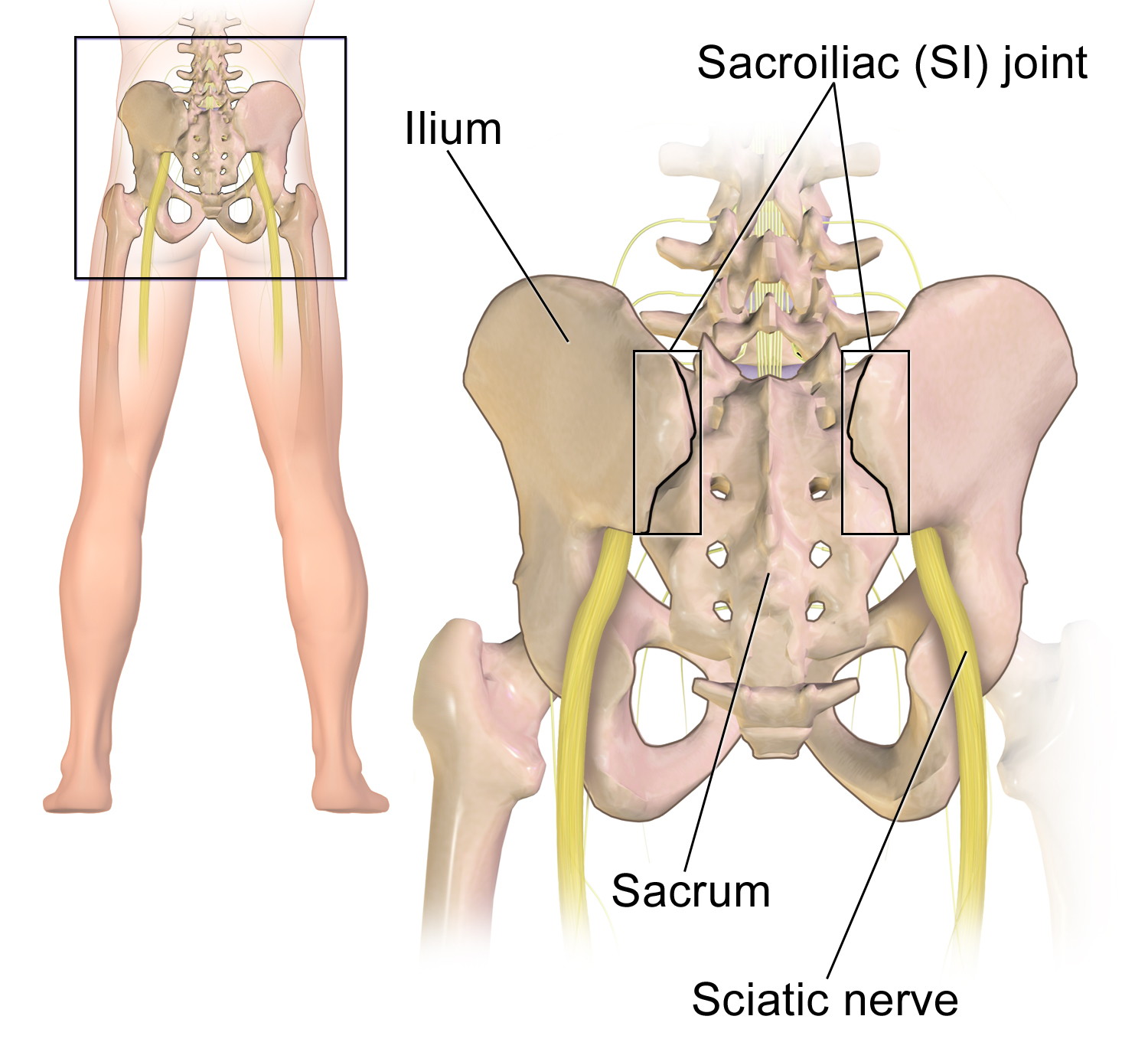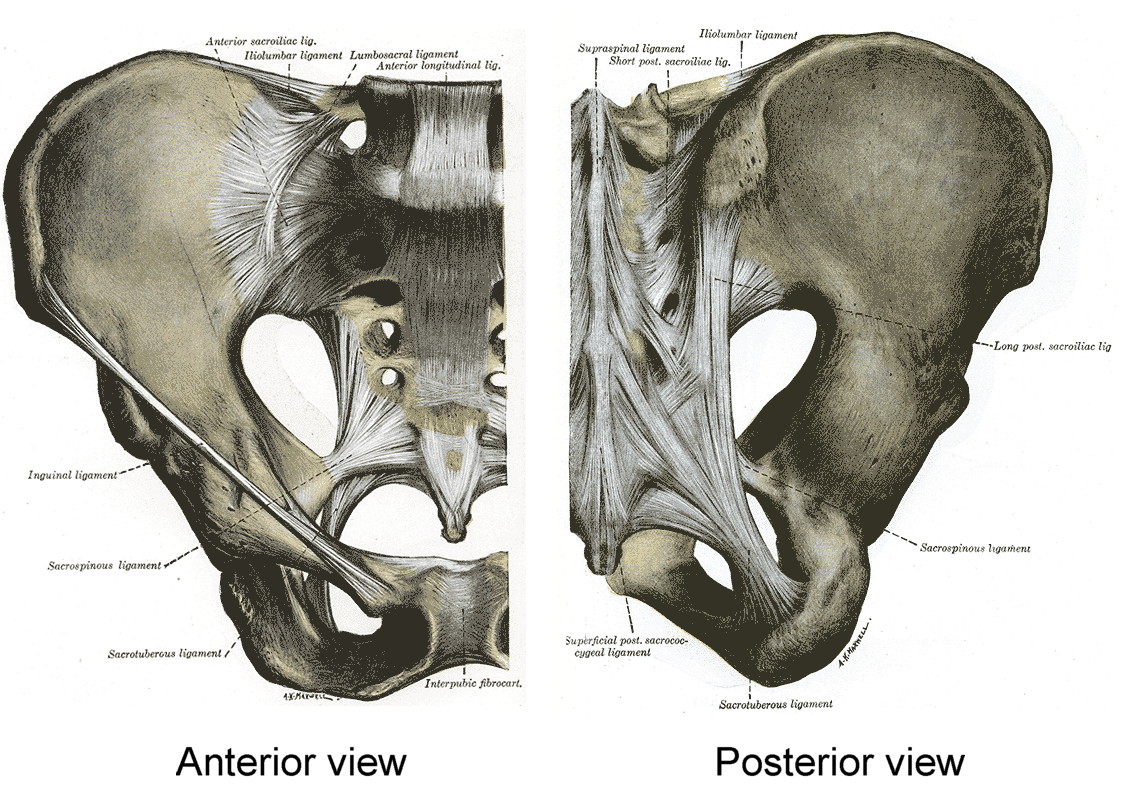The Causes of SI Joint Pain and Dysfunction
The sacroiliac joints are at the true center of our skeleton, so they bear the brunt of any imbalance or sudden force that occurs in our body.
In this post we’ll discuss the most common causes of sacroiliac joint pain and dysfunction: imbalanced posture and movement, chronic muscle tension, and ligament laxity due to injury or pregnancy. We’ll also discuss why Clinical Somatics exercises are the most effective way to prevent and alleviate degeneration and dysfunction of the sacroiliac joints.
What are the sacroiliac joints?
Between the ages of 18 and 30, the five sacral vertebrae fuse to form the sacrum, a triangular bone at the base of our spine. The sacrum sits in between the ilium bones of the pelvis. The sacroiliac joints (SI joints) are the joints where the sacrum and ilium meet.

Due to their location at the center of our skeleton, the SI joints have very important jobs: they support our spine and the entire weight of our upper body, transfer forces from our spine to our legs, and provide stability and mobility during movement.
The sacrum and ilium bones are connected by a strong system of ligaments. These ligaments provide support for the SI joints and allow a small but necessary amount of movement.

Symptoms of SI joint dysfunction
As we’ll discuss in the next section, issues such as imbalanced posture and movement, chronically tight muscles, and injury to or laxity of ligaments can all cause dysfunction of the SI joints. Common symptoms of SI joint dysfunction are:
- Pain in the lower back, SI joints, buttocks, hips, and groin
- Pain radiating down the legs
- Tingling, numbness, or weakness in the buttocks or legs
- Stiffness in the lower back
- Frequent urination
- Increased pain with stair climbing
- Increased pain when sitting, standing, or lying down for a long period of time
- Increased pain with menstruation or sexual intercourse
What causes SI joint pain and dysfunction?
The most common causes of SI joint dysfunction are:
- Imbalanced posture and movement that puts uneven stress on the SI joints
- Chronic muscle tightness in the lower back and gluteal muscles that causes compression of the SI joints
- Injury to the ligaments that support the SI joints
- Hormone changes during pregnancy that increase laxity of the ligaments that support the SI joints
If you tend to use the sides of your body differently—whether you kick a ball repeatedly with one leg or lean on one side as you work at your computer—you’ll develop different patterns of muscle tension on either side of your body. This muscle tension will pull your spine and pelvis out of alignment, often leading to scoliosis or functional uneven leg length.
Imagine how this uneven stress affects your SI joints. More pressure is put on one side than the other, and different patterns of movement are required from each joint. As a result, imbalanced posture and movement will most often lead to pain and degeneration of the SI joint on one side rather than both sides.
If you have a lot of chronic tension in your lower back and gluteal muscles—as many of us do due to stress, athletic training, heavy lifting, or sitting for long periods of time—your SI joints and lumbar spine will be compressed. When joints are constantly compressed, pressure is put on the cartilage that lines the joints, and it is gradually worn away. This degeneration usually involves painful inflammation, and sometimes leads to the growth of bone spurs that limit movement in the joint.
If you are pregnant or if you suffer an injury that damages one or more of the ligaments that support the SI joints, the joints can become hypermobile. When these joints move more than they should, or in patterns that they are not designed to move, pain and degeneration of the joints can occur.
In addition to pain, inflammation, and joint degeneration, you may feel that one or both SI joints pop out of alignment. This can occur from ligament laxity allowing too much movement, or from tight muscles and imbalanced posture and movement pulling the joint out of alignment.
How to prevent and alleviate SI joint pain with Clinical Somatics
The best ways to prevent and alleviate SI joint pain are to maintain balanced posture and movement, release muscle tension in your lower back and gluteal muscles, and avoid heavy lifting and activities that may injure your SI joint ligaments.
Clinical Somatics exercises use the movement technique of pandiculation to release chronic muscle tension. Our nervous system actually learns to keep our muscles tight over time due to repetitive activities and stress, and the only way to release this tension is to retrain the nervous system.
Likewise, imbalanced postural patterns related to SI joint dysfunction, like scoliosis and functional leg length discrepancy, are caused by tight muscles pulling the skeleton out of alignment. The most effective and efficient way to release these tight muscles is by retraining the nervous system with pandiculation. Proprioceptive exercises that retrain sitting and standing posture are also very helpful, and these are part of the Clinical Somatics learning process.
It’s important to understand why other methods may not be effective for SI joint pain and dysfunction. Static stretching may temporarily lengthen your muscles, but they’ll start tightening up within a few hours as your stretch reflex regains normal function. Chiropractic adjustments can realign your joints temporarily, but your habitual muscular patterns will pull your joints out of alignment again within a few hours or days. Traditional strengthening exercises may add to your chronic muscle tension; so, do strength-building exercises with care and read this post about core strength.
Clinical Somatics exercises are extremely effective not only for releasing chronic muscle tension and retraining posture and movement, but also for recovering from injuries and pregnancy and regaining functional strength. While they are not traditional strength-building exercises, the exercises teach you how to fully contract and release your muscles so that you can use them through their full range of motion. They also allow you to “wake up” muscles that you may not have voluntarily used in many years.
Since the SI joints are at the core of the body, there are many Clinical Somatics exercises that work with the muscles that affect the SI joints. If you are doing my online Level One & Two Courses, the following exercises will be most helpful for releasing the muscle tension and correcting the postural imbalances that lead to SI joint dysfunction:
From Level One:
Arch & Flatten
Back Lift
Arch & Curl
Side Curl
One-sided Arch & Curl
Iliopsoas Release
Diagonal Arch & Curl
Hip Rotation
Hamstring Release
From Level Two:
Lower Back Release
Proprioceptive Exercise 1
Proprioceptive Exercise 2
Gluteal Release
Iliotibial Band Release
Standing Hamstring Release

